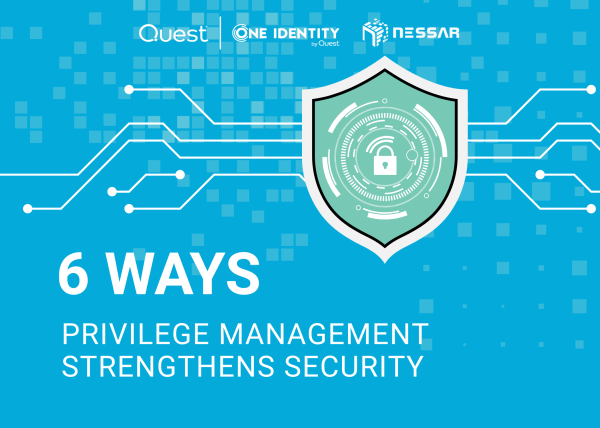Is your company really prepared for a cyber attack? – Part 2

Is your company really prepared for a cyber attack? – Part 2
In the previous article, we discussed the importance of digital transformation to business, and how this process brings various information security issues with it. Now we will talk a little bit about what are the most common cyberattacks on businesses today and what a weak cybersecurity posture can do to your business, particularly in the healthcare, technology, and payment industries.
See below why the loss of privileged credentials poses serious business risks and how your company can initiate a cyberattack response plan.
What Are Privileged Credentials?
It is becoming more common to hear about cyberattacks developed by people inside an organization than by outside hackers. This happens because its users, and particularly its most privileged users, are the biggest threat to its cybersecurity. After all, privileged credentials are also called keys to the kingdom, as they provide access to critical actions, such as modifying domain controller settings or transferring financial resources from an organization’s accounts.
These users already have keys to your kingdom and therefore it can be incredibly difficult to identify them and prevent them from abusing their privileges. An unsatisfied employee or someone who should never have had access to sensitive data can financially harm an organization and easily destroy its reputation.
Knowing this, everyone (not just IT and security teams) must understand what it means to be a privileged user and what you can do to help mitigate the threats they pose. Thus, in times of increased regulatory requirements, including new data protection legislation such as LGPD and GDPR, ensuring the protection of privileged credentials is more than reducing cyber risks and avoiding multi-million-dollar sanctions, it is ensuring business continuity.
What Are Cyber Threats Involving Privileged Credentials?
Because your privileged user accounts have higher access levels than other users, they need to be monitored more closely. The threats privileged user accounts pose can generally be summarized into three main categories.
Accidental Insider Threat
A significant proportion of insider threats are unintentionally caused. All users make mistakes, including those with privileged access. Due to the types of data they have access to, the mistakes privileged users make have far more serious consequences.
A careless user can make a change to critical business data without thinking about the consequences. Or they can grant unnecessary access to a file share when there is no need for such access. All of these actions unnecessarily put data at risk.
Malicious Insider Threat
Because your privileged user accounts already have access to sensitive data, intentional misuse can be harder to detect than a stranger trying to gain illegitimate access. These people sometimes use the fact that they are not monitored as closely as other users to intentionally abuse their privileges. Their attacks can be opportunistic or premeditated, but they can be devastating anyway.
Outside Invader
External attackers often target your privileged user accounts as they can use the elevated privileges to move around the network undetected. They might try to trick your privileged users into providing them with credentials through phishing attacks, or might try to gain access through brute force.
What Are the Strategies That Can Be Used to Respond to Cyberattacks?
When an incident happens, time is crucial. The longer it takes to respond, the more likely the risks will increase. That’s why it is essential to have an incident response plan. By preparing yourself in advance, you can act quickly to identify and mitigate damage.
Here are five important activities for developing an effective incident response plan.
Understand Cybersecurity Incidents
What is crucial here is that organizations understand what is normal in their environment and what the potential risks are. If an organization does not know what a normal scenario looks like, how would it detect the abnormal or malicious one?
An information security risk assessment conducted annually or whenever you make significant changes to your organization will help you answer these questions as you analyze how your confidential information is used and how issues can arise.
Make Sure Your Scope Is Appropriate
The number of risks you identify will be incredibly huge, and realistically you won’t be able to deal with all of them.
You must therefore decide which risks to prioritize. Your decision should be based on an assessment of each threat’s potential damage and the likelihood of its occurrence.
Create An Incident Response Plan
With your most important threats identified, it is time to create an incident response plan to deal with them. This is a six-step process:
Preparation: The policies, procedures, governance, communication plans, and technology controls you will need to detect a security incident and continue operations once it occurs.
- Identification: Organizations need to be able to detect a potential incident. They must understand what information is available and in what location. Logs also need integrity. Can you trust that an attacker has not changed the logs?
- Containment: How you will isolate the problem and prevent it from causing further damage.
- Eradication: You should confirm what happened and answer any other questions the organization has.
- Recovery: The process of returning to business as usual.
- Lessons Learned: The processes of evaluating the implications of procedures and policies, collecting metrics, meeting reporting and compliance requirements, and identifying lessons that need to be learned.
Train Your Team
The success of your incident response plan depends on how well your team executes it. This includes not just the people responsible for creating and executing the plan, but everyone in your organization.
After all, their work can be interrupted when the plan goes into effect, so you need to make sure they are prepared. This means informing them of the plan, explaining why it is in place, and providing the necessary training to enable them to follow it.
Roles, responsibilities, dependencies, and authorization are also critical. Is the incident team empowered to make difficult and important decisions that could impact the organization’s operations?
Final Thoughts
Cybersecurity is an important topic for every business in today’s hyperconnected world. With fast-growing technologies like cloud, mobility, and virtualization, the security boundaries are a bit blurred and not every organization adequately protects its valuable and confidential information.
As a result, cyberattacks and data leaks occur more frequently and that is why they are no surprise in the field of Information Security. With the increasing sophistication of attacks on organizations of all sizes, the question is not whether a company will suffer a cyberattack, but when that attack will occur and what the consequences will be.
Controlling privileged actions in an organization’s infrastructure enables IT systems to be protected from any attempt to perform malicious actions such as theft or improper modifications to the environment – both inside and outside the company.
In this context, a Privileged Access Management (PAM) solution can be considered an important tool to speed up the deployment of a cybersecurity infrastructure. Privileged Access Management is an area of identity security that helps organizations maintain full control and visibility over their most critical systems and data.
A robust PAM solution ensures that all user actions, including those taken by privileged users, are monitored and can be audited in the event of a security breach. Privileged access control not only reduces the impact of a breach but also builds resilience against other causes of disruption, including insider threats, misconfigured automation, and accidental operator error in production environments.
Source: senhasegura.com
View more post: nessar.net
Category: VENDORSNEWSSegura News







